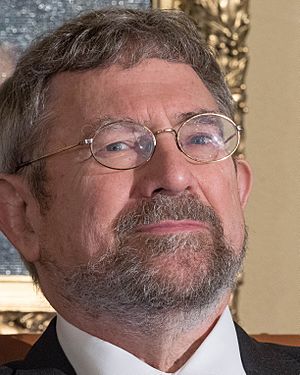J. Michael Kosterlitz facts for kids
Quick facts for kids
Michael Kosterlitz
|
|
|---|---|

Kosterlitz at Nobel press conference in Stockholm, Sweden, December 2016
|
|
| Born |
John Michael Kosterlitz
June 22, 1943 Aberdeen, Scotland, United Kingdom
|
| Nationality | British |
| Citizenship | United States |
| Alma mater |
|
| Known for | Berezinskii–Kosterlitz–Thouless transition KTHNY theory |
| Awards |
|
| Scientific career | |
| Fields | Condensed matter physics |
| Institutions | Brown University University of Birmingham Cornell University |
| Thesis | Problems in strong interaction physics (1969) |
| Academic advisors | David Thouless (postdoc) |
Michael Kosterlitz is a Scottish-American physicist. He was born on June 22, 1943. He is a professor of physics at Brown University. In 2016, he won the Nobel Prize in Physics along with David Thouless and Duncan Haldane. They received the award for their important work in condensed matter physics. This field studies how matter behaves in different states.
Contents
Early Life and School
Michael Kosterlitz was born in Aberdeen, Scotland. His parents were German-Jewish immigrants. His father, Hans Walter Kosterlitz, was a famous biochemist. Michael went to school at Robert Gordon's College and then the Edinburgh Academy.
He later studied at the University of Cambridge, where he earned his first degree. In 1969, he received his PhD from the University of Oxford.
Career and Discoveries
After finishing his studies, Michael Kosterlitz worked at several universities. These included the University of Birmingham and Cornell University. He worked closely with David Thouless at the University of Birmingham.
In 1974, he became a lecturer at the University of Birmingham. Since 1982, he has been a physics professor at Brown University in the United States. He also worked as a visiting researcher in Finland and as a distinguished professor in South Korea.
Kosterlitz's research focuses on condensed matter theory. This area of physics looks at how materials behave, especially in very thin layers or at very low temperatures. He studied how materials change from one state to another, like melting or freezing. He also researched random systems and how electrons move in materials.
Awards and Recognition
Michael Kosterlitz received the Nobel Prize in Physics in 2016. The prize was given for his "theoretical discoveries of topological phase transitions and topological phases of matter." This means he helped explain how materials can have unusual properties. These properties are linked to their "topology," which is like their shape or structure at a very tiny level.
He also won the Maxwell Medal and Prize in 1981. In 2000, he received the Lars Onsager Prize. These awards recognized his work on the Berezinskii–Kosterlitz–Thouless transition. This is a special kind of phase transition that happens in very thin materials. Since 1992, he has been a Fellow of the American Physical Society.
The Kosterlitz Centre at the University of Aberdeen is named after his father, Hans Kosterlitz. His father was a pioneering biochemist who studied endorphins. He joined the university after leaving Germany in 1934 during difficult times.
Personal Interests
Michael Kosterlitz was an early pioneer in Alpine climbing during the 1960s. He was known for climbing difficult routes in the UK, the Italian Alps, and Yosemite. There is even a climbing route in Italy named "Fessura Kosterlitz" after him.
He is an American citizen. He was diagnosed with multiple sclerosis in 1978.
See also
 In Spanish: Michael Kosterlitz para niños
In Spanish: Michael Kosterlitz para niños
- List of Jewish Nobel laureates

